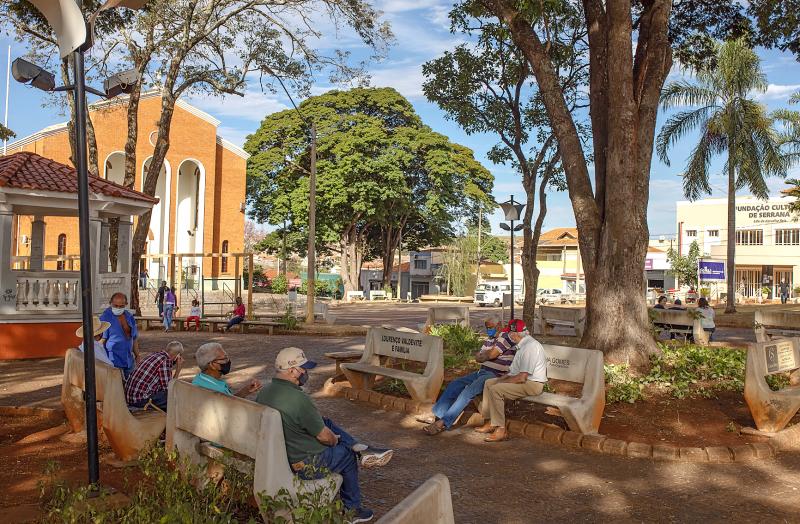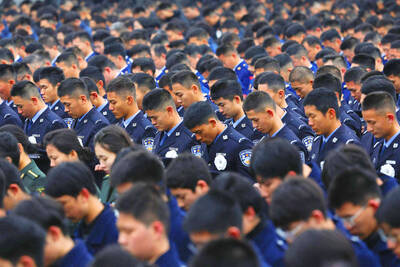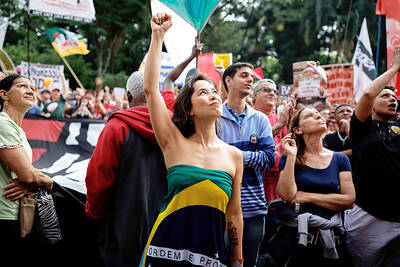Just one COVID-19 patient was in critical condition at the Dr Geraldo Cesar Reis clinic in Serrana, a city of almost 46,000 in Sao Paulo state’s countryside. The 63-year-old woman rejected the vaccine that was offered to every adult resident of Serrana as part of a trial.
Doctors have said the woman was awaiting one of Pfizer’s shots, which remain scarce in Brazil.
However, she is an outlier there. Most adults rolled up their sleeves when offered the vaccine made by the Chinese pharmaceutical company Sinovac, and the experiment has transformed the community into an oasis of near normalcy in a country where many communities continue to suffer.

Photo: Bloomberg
Doctors who treated COVID-19 in Serrana have seen their patient loads evaporate. They now help colleagues with other diseases and have started eating lunch at home.
Life has returned to the streets: Neighbors chat and families have weekend barbecues. Outsiders who previously had no reason to set foot in Serrana are arriving for haircuts and restaurant outings.
“We’re now as full as we used to be,” Rogerio Silva, a staffer at a store for cheap refreshments and snacks, said in an interview. “Weeks ago, people wouldn’t form a line in here, wouldn’t eat in and I wouldn’t let them use the bathroom. Now it’s back.”
The success story emerged as other population centers keep struggling with the coronavirus, enduring rising infections and new government-imposed restrictions.
Meanwhile, the vaccine appeared headed for wider use.
The WHO on Tuesday granted emergency use authorization to the Sinovac shot for people 18 or over, the second such authorization it has granted to a Chinese company.
The experiment known as “Project S” lasted four months and tested the Sinovac shot in real-world conditions.
The preliminary results made public on Monday suggest that the pandemic can be controlled if three-quarters of the population is fully vaccinated with Sinovac, said Ricardo Palacios, a director at the state’s Butantan Institute and coordinator of the study, which was not peer-reviewed.
“The most important result was understanding that we can control the pandemic even without vaccinating the entire population,” Palacios said.
The results offer hope to hundreds of millions of people, especially in developing nations. Egypt, Pakistan, Indonesia, Zimbabwe and others are likewise reliant on the Chinese shot, which is cheaper than vaccines from Pfizer and Moderna.
The city’s population was split into four geographic areas regardless of age and gender, and most adults received two shots by the end of April.
Results released on Monday showed that the pandemic was controlled after three of the areas had been vaccinated. It was not clear if vaccine uptake was the same in each area.
Serrana saw vast improvements: Deaths fell by 95 percent, hospitalizations by 86 percent and symptomatic cases by 80 percent.
The project “shows the protection exists and that the vaccine is effective. No doubt,” said Gonzalo Vecina, one of the founders of Brazil’s health regulator and a medical school professor.
The spread of the virus in Serrana slowed while neighboring communities, such as Ribeirao Preto, just 19km west, saw COVID-19 cases surge. The upswing was largely blamed on more contagious variants.
Hospitals in Ribeirao Preto are so full of COVID-19 patients that the mayor last week imposed strict shutdown measures, including halting public transportation and limiting hours for the city’s 700,000 residents to buy groceries.
Some would wait months for their vaccines. Almost all shops are closed, and 95 percent of intensive care unit beds are occupied by COVID-19 patients.
Just months ago, it was Serrana struggling to cope, said Joao Antonio Madalosso Jr, a physician.
For every patient who recovered in the first three months of this year, two more arrived in bad shape, he said.
“Then, by the end of January, we heard this project was coming to Serrana, and calmness set in, little by little,” said Madalosso, 32, as he pointed at the empty seats of the hospital’s COVID-19 ward. “Just look at this. This is much calmer than Ribeirao Preto and the entire region. The vaccine is no cure, but it is the solution to transform this into a light flu so people can carry on.”

The Burmese junta has said that detained former leader Aung San Suu Kyi is “in good health,” a day after her son said he has received little information about the 80-year-old’s condition and fears she could die without him knowing. In an interview in Tokyo earlier this week, Kim Aris said he had not heard from his mother in years and believes she is being held incommunicado in the capital, Naypyidaw. Aung San Suu Kyi, a Nobel Peace Prize laureate, was detained after a 2021 military coup that ousted her elected civilian government and sparked a civil war. She is serving a

China yesterday held a low-key memorial ceremony for the 1937 Nanjing Massacre, with Chinese President Xi Jinping (習近平) not attending, despite a diplomatic crisis between Beijing and Tokyo over Taiwan. Beijing has raged at Tokyo since Japanese Prime Minister Sanae Takaichi last month said that a hypothetical Chinese attack on Taiwan could trigger a military response from Japan. China and Japan have long sparred over their painful history. China consistently reminds its people of the 1937 Nanjing Massacre, in which it says Japanese troops killed 300,000 people in what was then its capital. A post-World War II Allied tribunal put the death toll

‘NO AMNESTY’: Tens of thousands of people joined the rally against a bill that would slash the former president’s prison term; President Lula has said he would veto the bill Tens of thousands of Brazilians on Sunday demonstrated against a bill that advanced in Congress this week that would reduce the time former president Jair Bolsonaro spends behind bars following his sentence of more than 27 years for attempting a coup. Protests took place in the capital, Brasilia, and in other major cities across the nation, including Sao Paulo, Florianopolis, Salvador and Recife. On Copacabana’s boardwalk in Rio de Janeiro, crowds composed of left-wing voters chanted “No amnesty” and “Out with Hugo Motta,” a reference to the speaker of the lower house, which approved the bill on Wednesday last week. It is

FALLEN: The nine soldiers who were killed while carrying out combat and engineering tasks in Russia were given the title of Hero of the Democratic People’s Republic of Korea North Korean leader Kim Jong-un attended a welcoming ceremony for an army engineering unit that had returned home after carrying out duties in Russia, North Korean state media KCNA reported on Saturday. In a speech carried by KCNA, Kim praised officers and soldiers of the 528th Regiment of Engineers of the Korean People’s Army (KPA) for “heroic” conduct and “mass heroism” in fulfilling orders issued by the ruling Workers’ Party of Korea during a 120-day overseas deployment. Video footage released by North Korea showed uniformed soldiers disembarking from an aircraft, Kim hugging a soldier seated in a wheelchair, and soldiers and officials